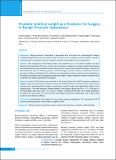Please use this identifier to cite or link to this item:
https://hdl.handle.net/20.500.14356/983Full metadata record
| DC Field | Value | Language |
|---|---|---|
| dc.contributor.author | Basnet, Surendra | - |
| dc.contributor.author | Shrestha, Parash Mani | - |
| dc.contributor.author | Shrestha, Anil | - |
| dc.contributor.author | Basnet, Robin Bahadur | - |
| dc.contributor.author | Regmi, Probodh | - |
| dc.contributor.author | Shah, Chitaranjan | - |
| dc.contributor.author | Shah, Arvind Kumar | - |
| dc.contributor.author | Mishra, Udita | - |
| dc.contributor.author | Adhikari, Baikuntha | - |
| dc.date.accessioned | 2023-04-18T10:45:53Z | - |
| dc.date.available | 2023-04-18T10:45:53Z | - |
| dc.date.issued | 2022 | - |
| dc.identifier.citation | BasnetS., ShresthaP. M., ShresthaA., BasnetR. B., RegmiP., ShahC., ShahA. K., MishraU., & AdhikariB. (2023). Prostatic Urethral Length as a Predictor for Surgery in Benign Prostatic Hyperplasia. Journal of Nepal Health Research Council, 20(3), 768-773. https://doi.org/10.33314/jnhrc.v20i3.4613 | en_US |
| dc.identifier.issn | Print ISSN: 1727-5482; Online ISSN: 1999-6217 | - |
| dc.identifier.uri | http://103.69.126.140:8080/handle/20.500.14356/983 | - |
| dc.description | Original Article | en_US |
| dc.description.abstract | Abstract Background: Benign prostatic hyperplasia is associated with structural and morphological changes including elongation of prostatic urethral length. The aim of our study was to assess whether prostatic urethral length could predict need of surgery in patients with benign prostatic hyperplasia. Methods: This prospective observational study was conducted over a 12-months duration. All the patients who presented with lower urinary tract symptoms secondary to benign prostatic hyperplasia were evaluated with International Prostate Severity Score, serum Prostate Specific Antigen, Transrectal Ultrasound was done to measure prostatic urethral length, prostate volume, Intravesical prostatic protusion and Post-void Residual Urine. Patients not responding to medical treatment and complications secondary to benign prostatic hyperplasia underwent surgery. Logistic regression analysis was performed to identify risk factors associated with surgery. Results: A total of 153 patients were included in the study. Eighty-three (54.2%) patients underwent surgery during the study period. Prostate volume, intravesical prostatic protrusion, post-void residual volume, serum prostate specific antigen, and prostatic urethral length were significantly higher in the surgical group. The mean prostatic urethral length in the surgical group was 39.47 + 10.2 mm and in the nonsurgical group was 26.20 + 6.72 mm (p <0.0001). According to the ROC curve-based prediction of surgery, the area under the curve for PUL was 0.866 and the best cutoff value was 31.5mm (81% sensitivity and 84.3% specificity). Conclusions: BPH patients with longer PUL may require surgical management. PUL measured by TRUS may be a predicting factor for the need of surgery in BPH Keywords: Benign prostatic hyperplasia; lower urinary tract symptoms; prostatic urethral length. | en_US |
| dc.language.iso | en | en_US |
| dc.publisher | Nepal Health Research Council | en_US |
| dc.relation.ispartofseries | July-Sep, 2022;4613 | - |
| dc.subject | Benign prostatic hyperplasia | en_US |
| dc.subject | lower urinary tract symptoms | en_US |
| dc.subject | prostatic urethral length | en_US |
| dc.title | Prostatic Urethral Length as a Predictor for Surgery in Benign Prostatic Hyperplasia | en_US |
| dc.type | Journal Article | en_US |
| Appears in Collections: | Vol 20 No 3 Issue 56 july-Sep, 2022 | |
Files in This Item:
| File | Description | Size | Format | |
|---|---|---|---|---|
| 4613-Manuscript-30791-1-10-20230314.pdf | fulltext download | 243.97 kB | Adobe PDF |  View/Open |
Items in DSpace are protected by copyright, with all rights reserved, unless otherwise indicated.
